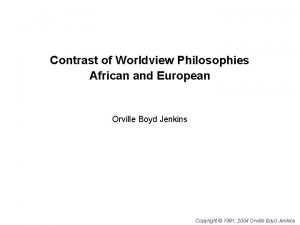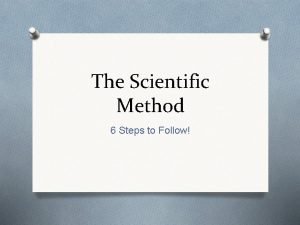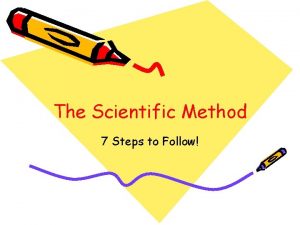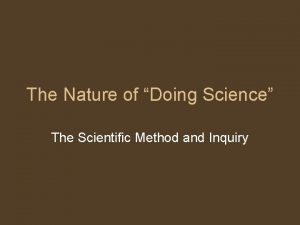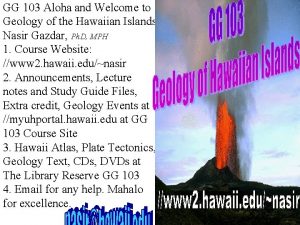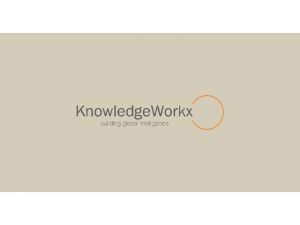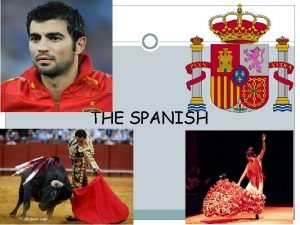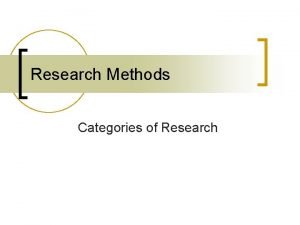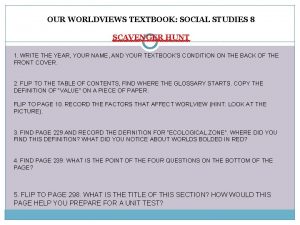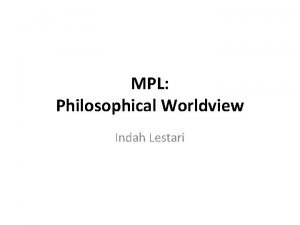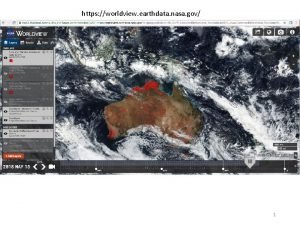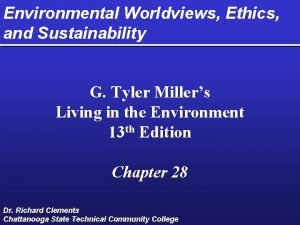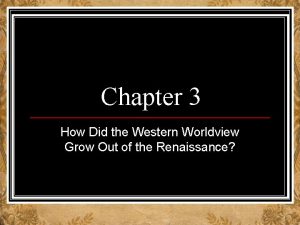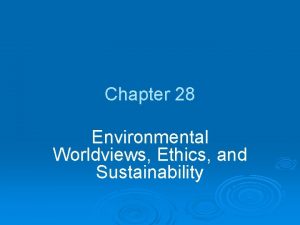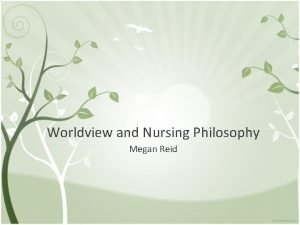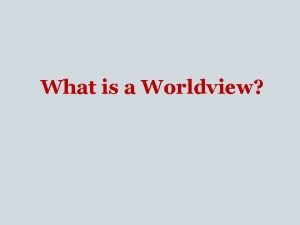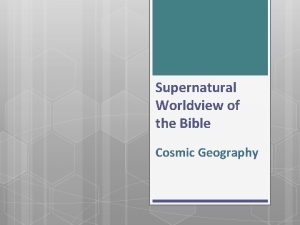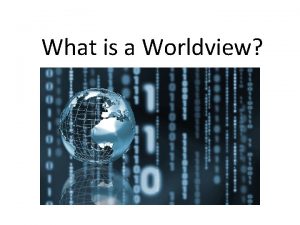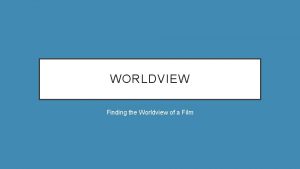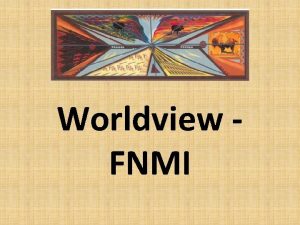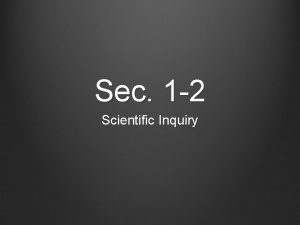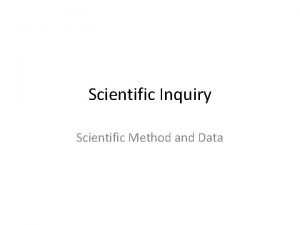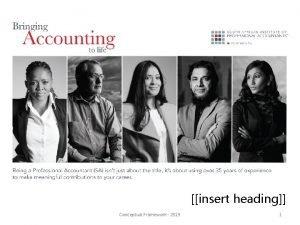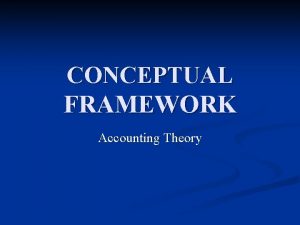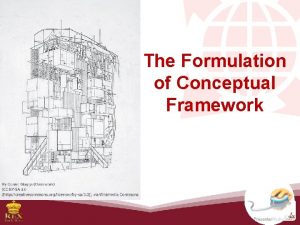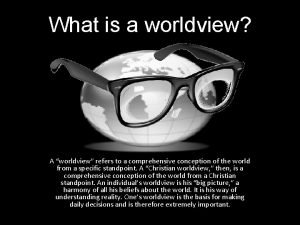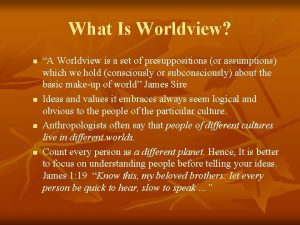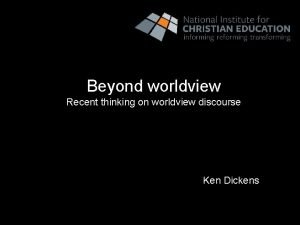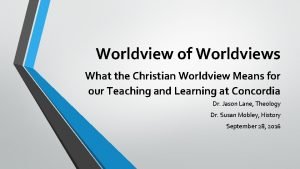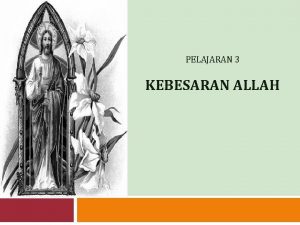A Conceptual Framework Scientific worldview Scientific inquiry Scientific



























- Slides: 27

A Conceptual Framework • Scientific worldview • Scientific inquiry • Scientific enterprise

• Scientific Worldview • The world is understandable – “Science presumes that the things and events in the universe occur in consistent patterns that are comprehensible through careful, systematic study. ” • Ideas are subject to change – “Change in knowledge is inevitable because new observations may challenge prevailing theories. ” • Knowledge is durable – “Although scientists reject the notion of attaining absolute truth and accept some uncertainty as part of nature, most scientific knowledge is durable. ” • Science Cannot Provide Complete Answers to All Questions – “There are many matters that cannot usefully be examined in a scientific way “

Scientific Inquiry • Sound empirical evidence – “Sooner or later, the validity of scientific claims is settled by referring to observations of phenomena. ” • Logic plus imagination – “Scientists do not work only with data and well-developed theories. ” • Science Explains and Predicts – “Scientists strive to make sense of observations of phenomena by constructing explanations for them that use, or are consistent with, currently accepted scientific principles. ” – “Theories should also fit additional observations that were not used in formulating theories in the first place; that is, theories should have predictive power. ”

Scientific Inquiry • Scientists Try to Identify and Avoid Bias – “But scientific evidence can be biased in how the data are interpreted, in the recording or reporting of the data, or even in the choice of what data to consider in the first place. ” • Not authoritarian – “In the long run, no scientist, however famous or highly placed, is empowered to decide for other scientists what is true, for none are believed by other scientists to have special access to the truth. ”

The Scientific Enterprise • Complex social activity – “Men and women of all ethnic and national backgrounds participate in science and its applications. “ • Science Is Organized Into Content Disciplines – “Organizationally, science can be thought of as the collection of all of the different scientific fields, or content disciplines. ” • Ethical principles – “Most scientists conduct themselves according to the ethical norms of science. ” • Scientist-as-citizen – “Scientists can bring information, insights, and analytical skills to bear on matters of public concern. ”

The Scientific Method The scientific method is the way that scientific psychologists gain knowledge about behavior and mental processes. – The scientific method is not a particular technique or tool. – Instead, it is a general approach to gaining knowledge. • Empirical • Systematic • Controlled We can compare the scientific method to our “everyday, ” nonscientific ways of gaining knowledge on several dimensions: see table 2. 1

Table 2. 1 Nonscientific Scientific General approach Intuitive Empirical Attitude Uncritical, accepting Critical, skeptical Observation Casual, uncontrolled Systematic, controlled Reporting Biased, subjective Unbiased, objective Ambiguous Clear definitions Instruments Inaccurate, imprecise Accurate, precise Measurement Not valid or reliable Valid and reliable Untestable Testable Concepts Hypothesis

General Approach Nonscientific • Intuitive – judgments and decisions are based on what “feels right. ” – Cognitive bias – Fast thinking – Confirmation bias – Illusory correlations What is an advantage of intuitive thinking? Scientific • Empirical – judgments and decisions are based on direct observation and experimentation. – What is an advantage of an empirical approach?

Observation Nonscientific • Casual, uncontrolled – personal biases and other factors influence observation. – Clever Hans example – Lukas smartest horse in the world Scientific • Systematic, controlled – control is the essential ingredient of science. – Scientists gain the greatest control when they conduct an experiment.

Observation (continued) • Control: Scientists investigate the effect of various factors one at a time in an experiment. • An experiment has at least one independent variable and at least one dependent variable. – Independent Variable (IV): A factor that researchers manipulate in order to determine the effect on behavior. • Manipulation of IV is a form of control • minimum of two levels: The treatment (experimental) condition and the control condition – Dependent Variable (DV): The measure of behavior that is used to assess the effect of the independent variable. • What was manipulated in the Clever Hans study?

Reporting • Nonscientific – Biased, subjective – Personal impressions • Scientific – Unbiased, objective – Separate observations from inferences – Interobserver agreement • Copyright © 2015 Mc. Graw-Hill Education. All rights reserved. No reproduction or distribution without the prior written consent of Mc. Graw-Hill Education.

Concepts • Nonscientific – Ambiguous: We use words even when not clear in their meaning (e. g. , “intelligence”) • Scientific use of constructs – Clear, specific definitions – Construct = concept • There are many psychological constructs. Examples: aggression, depression, emotion, intelligence, memory, personality, stress, well-being.

Constructs • An operational definition is the specific procedure used to produce and measure a construct. – How do we define Intelligence? • Advantages of operational definitions: – Allow scientists to define specifically what they mean by their construct – Allow clear communication among scientists. • Disadvantages: – A potentially limitless number of operational definitions exists for any particular construct such as intelligence • Need to have agreement on the use of constructs – Some operational definitions may be meaningless such as a paper and pencil test of intelligence with ethnocentric bias

Instruments • Nonscientific – Inaccurate, imprecise – Examples: gas gauges, measuring cup • Scientific – Accurate: calibrated by a standard • Yard stick to measure length • Stopwatch to measure time – Precise: level of detail • Length in mm instead of cm – Instrument accuracy and precision have improved across time see Figure 2. 3 – Psychological instruments include questionnaires

Measurements • Physical measurement involves dimensions that have agreed-upon standards and instruments. – Examples: length, weight, time • Psychological measurement is used to measure Psychological constructs such as: – beauty, intelligence, or aggression – Based on agreement between observers • Psychologists develop measures to assess these and other psychological constructs. – Produce operational definitions for psychological constructs “intelligence” – Create instruments to measure the construct “intelligence test”

Measurements • Measures must be valid and reliable. – Validity refers to truthfulness; a valid measure is one that measures what it claims to measure. • Example: tape measure of intelligence – Reliability refers to the consistency of a measure. • Get the same length with repeated measurements • OR, a measure is considered reliable when different observers consistently agree about an observation (interobserver) – Note that a measure may be reliable but not valid. • For example, tape measure of intelligence

Hypotheses • Tentative explanation for: – How are variables related • Example 1: purchasing green products is related to altruism • Example 2: stress results in poor health – Why the variables are related • Example 1: because of motives to increase social status • Example 2: because of immune system suppression • Hypotheses are not testable if they have any of these three characteristics: – Constructs are not adequately defined. – The hypothesis is circular — the event itself is used as an explanation of the event. – The hypothesis appeals to ideas or forces that are not recognized by science i. e. are not measureable

Goals of the Scientific Method • Description - Researchers define, classify, catalogue, or categorize events and their relationships to describe mental processes and behavior. • Prediction – Use relationships among variables to predict mental processes and behavior. • Explanation - Researchers understand can explain a phenomenon when they can identify its cause(s). • Application - Psychologists apply their knowledge and research methods to improve people’s lives. • See Table 2. 2

Description • Define, classify, catalogue, or categorize events and their relationships – For example clinical classification of selective mutism – Do not need to know diagnostic criteria • Most psychology research is nomothetic rather than idiographic. – Nomothetic: large sample sizes, “average” performance of a group – Idiographic: individual case studies • Most psychology research is quantitative rather than qualitative – Quantitative: statistical summaries of performance – Qualitative: verbal summaries of research findings

Prediction • When researchers identify correlations (relationships) among variables, they are able to make predictions – Example: As level of stress increases, individuals exhibit more health problems • A correlation occurs when two measures of the same people, events, or things vary together (covary) or go together. – As stress goes up health goes down – Useful for making predictions • Correlation does not imply causation. – We don’t know why the variables are correlated. – For example, there’s a correlation between the amount of hair in one’s ear and the presence of heart disease. (true) – Does this mean that having hair in one’s ears causes heart disease?

Explanation • Researchers understand can explain a phenomenon when they can identify its cause(s). – Researchers conduct controlled experiments to identify the causes of a phenomenon • Example: experiments demonstrate that stress suppresses the immune system – Need Control to make causal inferences • manipulate I. V. to determine their effect on the dependent variables. • Compare a control group to the experimental group • Hold conditions constant, testing environment is constant – confounding occurs when something other then the I. V. is changing

Explanation (continued) • Three conditions for making a causal inference: • Covariation of events: If one event causes the other, the two events must vary together (when one changes, the other must change also). • When stress increases health decreases • Time-order relationship: The presumed cause must occur before the presumed effect. • Stress produces health problems • Elimination of plausible alternative causes: We accept a causal explanation only when other possible causes of the effect have been ruled out. • No other cause of health problems are known

Application • Applied Psychologists apply their knowledge and research methods to improve people’s lives. – Applied Research: Psychologists conduct research to change people’s lives for the better. • Applied research is often conducted in natural settings – Schools, clinics, work place – Basic Research: Psychologists conduct research to understand behavior and mental processes — “seeking knowledge for its own sake. ” • Basic research is often carried out in laboratory settings with the goal of testing theories.

Scientific Theory Construction and Testing • Theories are proposed explanations for the causes of phenomena. – A theory is a logically organized set of statements that • define events (concepts), • describe relationships among these events, and • explain the occurrence of these events. • Vary in their scope and complexity – Theory of Schizophrenia vs evolution

Psychological Theories – Successful theories • organize what we know about a behavior or mental process (empirical knowledge), • guide future research by suggesting testable hypotheses, and • survive rigorous testing (such as falsification). – Good theories are logical and internally consistent, precise, and parsimonious. – Intervening Variables to explain the relationship between an I. V. and a D. V. • “hidden” processes that are represented by psychological constructs • Example thirst see fig 2. 6

Intervening Variables, Figurer 2. 6 • Copyright © 2015 Mc. Graw-Hill Education. All rights reserved. No reproduction or distribution without the prior written consent of Mc. Graw-Hill Education.

Psychological Theories • Intervening Variables – To explain the relationship between an I. V. and a D. V. – “hidden” processes that are represented by psychological constructs • Example: Pennebaker and Francis (1996) found that emotional writing about adjusting to college, compared to superficial writing, caused students to have higher GPAs. • They proposed an intervening variable: Emotional writing causes cognitive change (e. g. how people think about college), which causes higher GPAs.
 African worldview vs. european worldview
African worldview vs. european worldview Information gathered during an experiment
Information gathered during an experiment Sample of theoretical framework
Sample of theoretical framework Conceptual framework example
Conceptual framework example Conceptual framework theoretical framework
Conceptual framework theoretical framework Conceptual framework vs theoretical framework
Conceptual framework vs theoretical framework List 6 steps of the scientific method
List 6 steps of the scientific method What are the 7 steps of the scientific method
What are the 7 steps of the scientific method Define scientific inquiry
Define scientific inquiry Nature of scientific inquiry
Nature of scientific inquiry Nature of scientific inquiry
Nature of scientific inquiry World views definition
World views definition Layers of culture
Layers of culture Supernatural elements of the bible
Supernatural elements of the bible Spanish worldview
Spanish worldview Worldview examples
Worldview examples Categories of research design
Categories of research design Our worldviews
Our worldviews Postpositivism worldview
Postpositivism worldview Https://worldview.earthdata.nasa.gov/
Https://worldview.earthdata.nasa.gov/ Environmental worldviews
Environmental worldviews Western worldview examples
Western worldview examples Environmental worldviews, ethics, and sustainability
Environmental worldviews, ethics, and sustainability Worldview in nursing
Worldview in nursing Stewardship worldview definition
Stewardship worldview definition What is a worldview
What is a worldview Cosmic geography heiser
Cosmic geography heiser Naturalistic worldview
Naturalistic worldview
